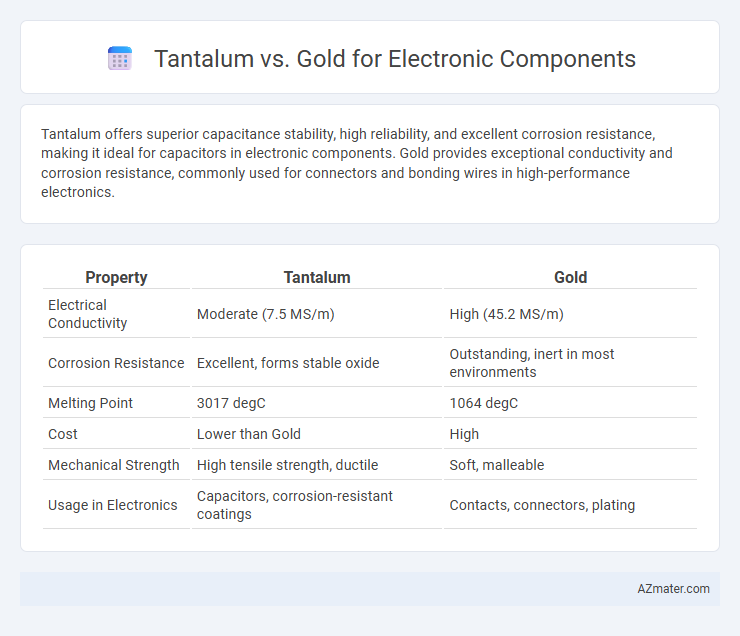Tantalum offers superior capacitance stability, high reliability, and excellent corrosion resistance, making it ideal for capacitors in electronic components. Gold provides exceptional conductivity and corrosion resistance, commonly used for connectors and bonding wires in high-performance electronics.
Table of Comparison
| Property | Tantalum | Gold |
|---|---|---|
| Electrical Conductivity | Moderate (7.5 MS/m) | High (45.2 MS/m) |
| Corrosion Resistance | Excellent, forms stable oxide | Outstanding, inert in most environments |
| Melting Point | 3017 degC | 1064 degC |
| Cost | Lower than Gold | High |
| Mechanical Strength | High tensile strength, ductile | Soft, malleable |
| Usage in Electronics | Capacitors, corrosion-resistant coatings | Contacts, connectors, plating |
Introduction to Tantalum and Gold in Electronics
Tantalum is prized in electronics for its high capacitance per volume and excellent corrosion resistance, making it ideal for capacitors in compact devices. Gold is widely used for its superior conductivity and resistance to oxidation, ensuring reliable connections in connectors and contacts. Both metals play crucial roles in enhancing performance and durability of electronic components.
Material Properties: Tantalum vs Gold
Tantalum exhibits excellent corrosion resistance, high melting point (3017degC), and superior capacitance stability, making it ideal for capacitors in electronic components. Gold offers exceptional electrical conductivity (approximately 45.2 MS/m) and resistance to oxidation, ensuring reliable connections in PCB contacts and bonding wires. While tantalum provides robust performance in harsh environments, gold's inertness and conductivity make it indispensable for critical circuit pathways.
Conductivity Comparison
Tantalum exhibits moderate electrical conductivity, making it suitable for capacitors where stability and reliability under high temperatures are essential, but it falls short compared to gold's exceptional conductivity of 44.2 million Siemens per meter. Gold, with superior conductivity and excellent corrosion resistance, is preferred for critical electronic contacts and connectors, ensuring minimal signal loss and long-term performance. While tantalum's conductivity supports efficient energy storage in capacitors, gold's unmatched conductivity enhances high-frequency signal integrity in advanced electronic components.
Corrosion Resistance and Durability
Tantalum exhibits exceptional corrosion resistance, especially against acidic environments, making it highly durable for electronic components exposed to harsh conditions. Gold, while offering superior corrosion resistance against oxidation and excellent conductivity, is softer and more prone to mechanical wear than tantalum. The durability of tantalum in high-temperature and corrosive applications often surpasses gold, providing a more resilient choice for long-term electronic component performance.
Cost Analysis: Tantalum vs Gold
Tantalum offers a cost-effective solution for electronic components compared to gold, with raw material prices significantly lower--tantalum averages around $200 per kilogram while gold can exceed $60,000 per kilogram. The manufacturing expenses for tantalum capacitors remain substantially less due to easier processing and lower material wastage. Despite gold's superior conductivity and corrosion resistance, tantalum's economic advantages make it a preferred choice in budget-sensitive electronic applications.
Solderability and Manufacturing Process
Tantalum offers superior solderability compared to gold due to its excellent wetting properties and stable oxide layer that enhances solder joint reliability in electronic components. The manufacturing process for tantalum capacitors involves sintering powdered tantalum, which allows for precise control of capacitance and miniaturization, whereas gold requires complex deposition and plating techniques that increase production costs. Tantalum's compatibility with automated surface-mount technology (SMT) lines ensures high yield and efficiency in mass production, while gold components often face challenges related to solder joint brittleness and cost-effectiveness.
Applications in Electronic Components
Tantalum and gold are essential materials in electronic components, each offering unique advantages; tantalum is widely used in capacitors due to its high capacitance per volume and excellent stability in miniaturized devices. Gold's superior conductivity and resistance to corrosion make it ideal for reliable electrical contacts, connectors, and wire bonding in high-performance circuits. Applications including smartphones, medical devices, and aerospace electronics benefit from tantalum capacitors' energy density and gold-plated connectors' long-term durability.
Environmental and Health Considerations
Tantalum, sourced primarily from conflict-affected regions, raises significant environmental and ethical concerns due to mining practices that contribute to habitat destruction and human rights violations. Gold mining entails extensive land degradation, mercury pollution, and toxic waste generation, posing severe risks to ecosystems and workers' health. Both metals require sustainable sourcing and rigorous health and safety measures to mitigate their environmental impact in electronic component manufacturing.
Technology Trends and Industry Preferences
Tantalum capacitors dominate the electronics industry due to their superior volumetric efficiency and high capacitance stability, which are critical for miniaturized, high-performance devices like smartphones and medical implants. Gold remains essential in electronic components for its exceptional corrosion resistance and excellent electrical conductivity, especially in connectors and bonding wires where reliable signal transmission is paramount. Current technology trends favor integrating tantalum capacitors in compact circuits, while gold continues to be preferred for precision and durability in high-frequency and aerospace applications.
Conclusion: Choosing Between Tantalum and Gold
Tantalum offers excellent capacitance and stability in electronic components, making it ideal for high-performance applications requiring reliability and miniaturization. Gold provides superior corrosion resistance and conductivity, which is crucial for connectors and contacts exposed to harsh environments. Selecting between tantalum and gold depends on the specific electronic function, durability requirements, and cost considerations, with tantalum favored for capacitors and gold preferred for connectors.

Infographic: Tantalum vs Gold for Electronic Component
 azmater.com
azmater.com